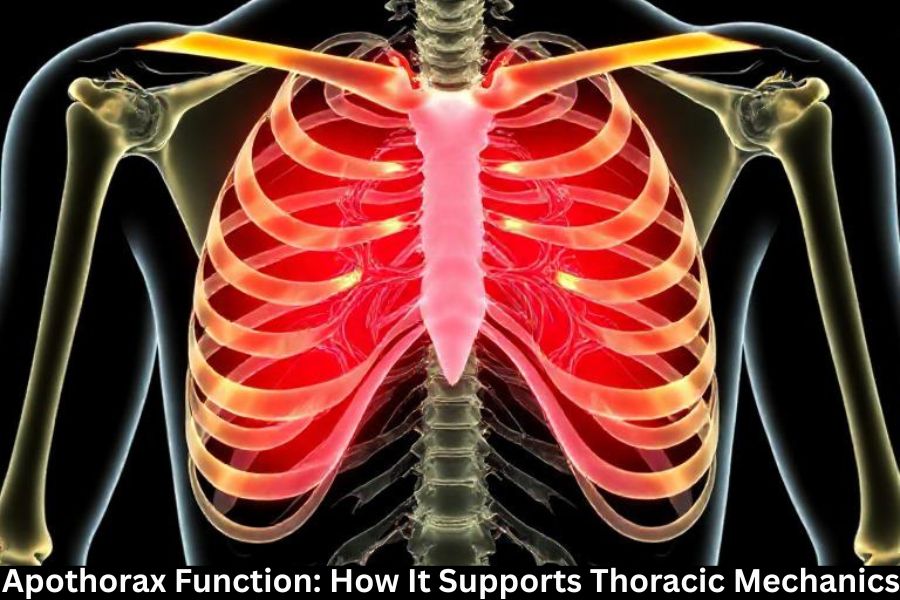Apothorax Function: How It Supports Thoracic Mechanics
Thoracic mechanics refers to the biomechanical processes that allow the thoracic region (or the chest) to function optimally. This includes the movement and flexibility of the rib cage, spine, and surrounding muscles, which work together to facilitate breathing, protect vital organs, and support various upper body movements.
The Role of Apothorax in Thoracic Function
The apothorax, a term not widely known outside of specialized anatomical contexts, plays a critical role in the mechanics of the thoracic region. It supports vital functions like respiration and posture control. Though it’s a relatively obscure term, understanding its function can significantly improve our grasp of thoracic mechanics and the treatment of thoracic disorders.
What is Apothorax?
Defining Apothorax
Apothorax is a specialized structure located within the thoracic region. It’s often described as a system of connective tissues, tendons, and muscle fibers that help stabilize and protect the thoracic spine and rib cage. Essentially, it acts as a bridge that supports both the respiratory system and upper body movements.
Apothorax and Its Relationship with Thoracic Function
The apothorax interacts closely with various muscles, including the diaphragm, intercostals, and even the abdominal muscles. By connecting these structures, the apothorax enhances thoracic mechanics, facilitating both breathing and mobility. In other words, apothorax is essential in ensuring that the chest can expand and contract efficiently during breathing, while also contributing to posture and movement.
Anatomy of the Thoracic Region
Structure of the Thorax
The thoracic region includes the thoracic spine, rib cage, sternum, and the diaphragm. The ribs form a protective cage around the heart and lungs, while the spine provides structural support and flexibility for movement. The diaphragm, a large muscle under the rib cage, plays a key role in respiration.
Key Muscles and Ligaments Supporting the Thorax
Several muscles contribute to the proper functioning of the thorax. These include the intercostal muscles, which sit between the ribs and help with breathing, and the erector spinae, which aids in spinal support. Ligaments such as the costovertebral and costotransverse ligaments also help to stabilize the rib cage.
The Role of Apothorax in Respiration
How Apothorax Affects Breathing Mechanics
Breathing is a complex process involving the expansion and contraction of the rib cage. The apothorax stabilizes key areas of the rib cage and assists in the coordinated movement of the ribs and diaphragm during the inhalation and exhalation process. Without the support of the apothorax, the mechanics of deep breathing would be less efficient, leading to restricted airflow and fatigue.
The Interaction Between Apothorax and Diaphragm
The diaphragm is the primary muscle responsible for breathing, and it works in harmony with the apothorax. As the diaphragm contracts and moves downward during inhalation, the apothorax ensures that the rib cage expands and the thoracic cavity enlarges. This interaction is vital for optimal lung expansion and efficient oxygen intake.
Apothorax and Posture Control
How Apothorax Impacts Spinal Alignment
Apothorax doesn’t just support respiration—it also plays a crucial role in maintaining good posture. By stabilizing the muscles around the thoracic spine, it helps maintain proper alignment. This reduces strain on the spine and surrounding muscles, which is particularly important for individuals who sit for long periods or perform repetitive tasks.
Relationship Between Apothorax and Core Stability
The apothorax also interacts with the core muscles, particularly the abdominal and lower back muscles. A well-functioning apothorax ensures that these muscles work together to provide stability to the thoracic region. This stability is essential for maintaining a healthy posture and preventing musculoskeletal issues.
Apothorax in Movement and Mobility
Supporting Upper Limb Motion
The apothorax plays an indirect but essential role in facilitating upper limb motion. The rib cage and spine need to be flexible for the shoulders and arms to move freely. The apothorax ensures that the rib cage remains sufficiently flexible and stable to support the wide range of motions required for activities such as lifting, throwing, and reaching.
Facilitating Rotational Movements
The thoracic region is crucial for rotational movements in the torso. Whether it’s twisting to reach behind you or rotating your torso during athletic activities, the apothorax ensures that the rib cage moves fluidly, allowing for these complex movements without compromising spinal integrity.
Pathologies Related to Apothorax Dysfunction
Consequences of Apothorax Dysfunction on Thoracic Mechanics
When the apothorax is not functioning properly, it can lead to a variety of issues. Dysfunction in this area can cause restricted movement in the rib cage, poor breathing mechanics, and even chronic pain. Additionally, a misalignment of the apothorax can exacerbate postural issues, leading to spinal misalignments and discomfort.
Common Disorders Linked to Apothorax Problems
Conditions like thoracic outlet syndrome, rib dysfunctions, and chronic respiratory issues can often be traced back to apothorax-related dysfunctions. These disorders may cause pain, stiffness, and decreased lung capacity, making daily activities more challenging.
Therapeutic Approaches to Apothorax Dysfunction
Chiropractic Interventions
Chiropractic care can be highly effective in treating apothorax dysfunction. Through spinal adjustments and manipulations, chiropractors can realign the thoracic spine, release muscle tension, and improve the overall function of the apothorax. This often leads to improved posture, better breathing, and reduced pain.
Physiotherapy Techniques
Physical therapy focuses on strengthening the muscles supporting the thoracic region, including those affected by apothorax dysfunction. Techniques such as stretching, strengthening exercises, and posture training can restore optimal function and reduce discomfort.
Surgical Options for Severe Dysfunction
In cases of severe apothorax dysfunction, surgical intervention may be required. This could include procedures to address structural issues in the rib cage or spine that are preventing normal function. Surgery is typically considered a last resort after other non-invasive therapies have been exhausted.
Preventive Measures for Apothorax Health
Postural Training
Good posture is one of the best ways to prevent apothorax dysfunction. By training the body to maintain proper alignment, individuals can reduce the strain on the thoracic region and prevent long-term issues.
Breathing Exercises and Techniques
Breathing exercises, particularly those focused on diaphragmatic breathing, can strengthen the muscles of the thoracic region and improve lung capacity. Techniques such as yoga and Pilates often incorporate breathing exercises that help maintain healthy thoracic mechanics.
Strengthening the Core and Thoracic Muscles
A strong core is essential for supporting the thoracic region. Core-strengthening exercises, along with thoracic mobility exercises, can ensure that the apothorax and surrounding muscles remain functional and efficient.
Research and Future Directions
Advancements in Apothorax Studies
Research into apothorax function is still relatively limited, but advancements in biomechanics and musculoskeletal health are shedding light on its importance. Future studies may help us better understand how to optimize thoracic mechanics and treat related disorders more effectively.
The Future of Thoracic Mechanics and Apothorax Function
As understanding of thoracic mechanics grows, so too will our ability to develop more effective treatments for apothorax dysfunction. Innovative technologies, like robotic surgery and advanced physiotherapy techniques, may soon provide new solutions for improving apothorax health.
Conclusion
Summary of Apothorax Function in Thoracic Mechanics
Apothorax is a vital part of thoracic mechanics, influencing respiration, posture, movement, and overall upper body function. It connects key muscles and structures in the thoracic region, ensuring smooth, coordinated actions.
The Importance of Maintaining Apothorax Health for Overall Wellness
Maintaining healthy apothorax function is crucial not only for proper breathing and posture but also for long-term musculoskeletal health. By understanding and addressing any dysfunctions, individuals can improve their quality of life and prevent long-term issues.
FAQs
1. What are the common symptoms of apothorax dysfunction?
Symptoms of apothorax dysfunction can include pain in the upper back, difficulty breathing, poor posture, and restricted movement in the rib cage.
2. Can apothorax dysfunction affect athletic performance?
Yes, apothorax dysfunction can limit mobility and flexibility, reducing athletic performance, particularly in activities requiring rotational movements or endurance.
3. How can I strengthen my thoracic region to support apothorax function?
Exercises focusing on core strength, thoracic mobility, and diaphragmatic breathing can help maintain a healthy apothorax and improve overall thoracic function.
4. Is chiropractic care effective for treating apothorax dysfunction?
Chiropractic care can be highly effective in realigning the thoracic spine and improving the function of the apothorax, leading to better posture, breathing, and reduced pain.
5. Are there any long-term complications of untreated apothorax dysfunction?
Untreated apothorax dysfunction can lead to chronic pain, poor posture, decreased lung function, and potentially more severe musculoskeletal issues over time.
Share this content:



